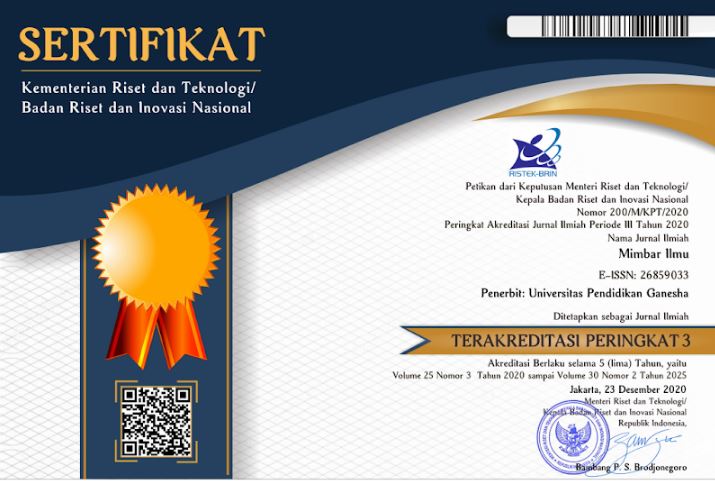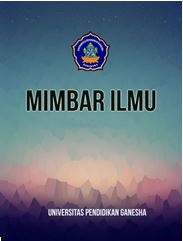Indonesian Sound Errors in Television Advertisements
DOI:
https://doi.org/10.23887/mi.v29i1.73129Keywords:
language sounds, television advertising, phonologyAbstract
Language sound errors at the phonological level. Phonemes or language sounds in Indonesian consist of vowels, consonants, diphthongs 'double vowels', and clusters 'consonant groups'. Differences in phonemes will change standard language varieties into non-standard ones. Phonological problems occur because vowel, consonant or diphthong phonemes change into other phonemes, thereby changing standard language into non-standard ones. This research aims to analyze language sound errors, namely deletions, additions and changes in vowel phonemes, consonant phonemes, combined vowel phonemes and combined consonant phonemes. This study used descriptive qualitative method. The data collection technique for this research is by listening and using the language watched in Indonesian television advertisements. This data analysis technique consists of (1) data collection (2) data reduction, (3) data presentation (4) interesting conclusions. The results of data analysis of Indonesian language sound errors in Television Advertisements are language sound errors in Indonesian consisting of vowels, consonants, diphthongs 'double vowels', and 'consonant clusters' clusters due to errors in language use that do not match Indonesian Spelling (EBI) . Errors in Indonesian sounds or pronunciation that occur in television advertisements like this occur due to ignorance or on purpose so that the advertisement displayed will attract the attention of consumers or people who see, watch and listen to it.
References
Arikunto, S. (2013). Dasar-dasar Evaluasi Pendidikan (2nd ed.). Bumi Aksara.
Denham, B. E. (2021). Deception in Weight Loss Advertising: Newspaper use of Press Releases Issued by the Federal Trade Commission. Newspaper Research Journal, 42(2), 198–214. https://doi.org/10.1177/07395329211013994.
Fitriana, I. (2013). Translation Analysis of Directive Speech Acts in" Eat Pray Love" Novel and Its Translation into Indonesian. Prasasti: Journal of Linguistics, 2(2). https://doi.org/10.20961/prasasti.v2i2.332
Gelen Assoc, I. (2018). Academicians’ Predictions Of 21 St Century Education And Education In The 21 St Century. European Journal of Education Studies, 4, 165–204. https://doi.org/10.5281/zenodo.1233478.
Greaney, K., & Arrow, A. (2014). The Importance of Teaching Phonological-Based Spelling Skills. Kairaranga, 15(1), 20–25. https://doi.org/10.54322/kairaranga.v15i1.182.
Harahap, D. P. (2020). Penggunaan Metode Silabel dalam Meningkatkan Kemampuan Membaca pada Siswa Using Syllable Method in Improving Student’s Reading Skill. Jurnal Penelitian Pendidikan, Psikologi Dan Kesehatan (J-P3K), 1(1), 15–22. https://doi.org/10.51849/j-p3k.v1i1.14.
Hidayat, D. N., Abrizal, A., & Alek, A. (2019). A multimodal discourse analysis of the interpersonal meaning of a television advertisement in Indonesia. IJEE (Indonesian Journal of English Education), 5(2), 119–126. https://doi.org/10.15408/ijee.v5i2.11188.
Ho, P. (2015). Common Errors in Writing Journals of the English-Major Students At Hcmc Open University. Journal of Science Ho Chi Minh City Open University, 2(JUNE), 52–61. https://journalofscience.ou.edu.vn/index.php/soci-en/article/view/315.
Istima, & Polisida, Y. (2016). English, Translating Verbs, Phrasal Indonesian, Into. Pedagogy: Journal of English Language Teaching, 2, 36–56. https://e-journal.metrouniv.ac.id/index.php/pedagogy/article/view/1431.
Law, J. M., De Vos, A., Vanderauwera, J., Wouters, J., Ghesquière, P., & Vandermosten, M. (2018). Grapheme-phoneme learning in an unknown orthography: A study in typical reading and dyslexic children. Frontiers in Psychology, 9(AUG), 1–10. https://doi.org/10.3389/fpsyg.2018.01393.
Leung, C. (2022). Language proficiency: from description to prescription and back? Educational Linguistics, 1(1), 56–81. https://doi.org/10.1515/eduling-2021-0006.
Miles, M. B., Huberman, A. M., & Saldaña, J. (2018). Qualitative data analysis: A methods sourcebook. Sage Publications.
Montaner Sanchis, A., Gumbau Puchol, V., Villalba Ferrer, F., & Eleuterio Cerveró, G. (2022). Mobile learning in human anatomy: Application market study. Educacion Medica, 23(2). https://doi.org/10.1016/j.edumed.2022.100726.
Munandar, A. (2016). Pemakaian Bahasa Jawa dalam Situasi Kontak Bahasa di Daerah Istimewa Yogyakarta. Humaniora, 25(1), 92–102. https://doi.org/10.22146/jh.1819.
Naderer, B. (2021). Advertising Unhealthy Food to Children: on the Importance of Regulations, Parenting Styles, and Media Literacy. Current Addiction Reports, 8(1), 12–18. https://doi.org/10.1007/s40429-020-00348-2.
Novianti, R., Syihabuddin, & Rochyadi, E. (2019). Phonology-based reading instruction to improve dyslexic students’ early reading ability. Indonesian Journal of Applied Linguistics, 9(2), 443–451. https://doi.org/10.17509/ijal.v9i2.20242.
Olowu, A., & Akinkurolere, S. O. (2015). A multimodal discourse analysis of selected advertisement of malaria drugs. English Review: Journal of English Education, 3(2), 1–8. http://journal.uniku.ac.id/index.php/ERJEE/article/view/205.
Paul, R., Norbury, C., & Gosse, C. (2018). Assessing students’ language for learning. Language Disorders from Infancy Through Adolescence, 440–502. https://doi.org/10.1016/b978-0-323-44234-3.00020-8
Puspitasari, R. D., & Dewanti, A. (2020). Code switching in Sarah Sechan talk show on NET TV. Utopía y Praxis Latinoamericana: Revista Internacional de Filosofía Iberoamericana y Teoría Social, 1, 462–472. https://dialnet.unirioja.es/servlet/articulo?codigo=7411415.
Raghupathi, V., & Fogel, J. (2013). Facebook Advertisements and Purchase of Weight Loss Products. Journal of Medicinal Marketing, 13(4), 201–211. https://doi.org/10.1177/1745790414531427.
Rahayu, N. (2019). Students’ Perceptions on the Application of Standardized English Language Proficiency Test as Graduation Requirement in Tourism Higher Education in Indonesia (A Case Study at Trisakti School of Tourism). Tourism Research Journal, 3(2), 153–166. https://doi.org/10.30647/trj.v3i2.60.
Rahmawati, F., & Ramadan, Z. H. (2021). Improving High-Level Thinking Skills in Students Through Powtoon-Based Animation Video Media. Journal of Education Technology, 5(4), 654. https://doi.org/10.23887/jet.v5i4.41037.
Rahmayanti, P., Suwastini, N. K. A., Dantes, G. R., & Kultsum, U. (2021). Indonesian college students’ perception toward language online learning before and during COVID-19 Pandemic. Journal of Education Technology, 6(1), 56–66. https://doi.org/10.23887/jet.v6i1.41561.
Sadler, R. C., Arku, G., & Gilliland, J. A. (2015). Local Food Networks As Catalysts For Food Policy Change To Improve Health And Build The Economy. Local Environment: The International Journal of Justice and Sustainability, 20(9), 1103–1121. https://doi.org/10.1080/13549839.2014.894965.
Sakti, P. (2020). Mapping and phonologycal process of bimanese. Jurnal Psimawa, 3(1), 39–41. https://doi.org/10.1234/jp.v3i1.606.
Strouse, G. A., Nyhout, A., & Ganea, P. A. (2018). The role of book features in young children’s transfer of information from picture books to real-world contexts. Frontiers in Psychology, 9(FEB), 1–14. https://doi.org/10.3389/fpsyg.2018.00050.
Sugiyono. (2016). Metode Penelitian Pendidikan. ALFABETA.
Sumardi, A. (2018). Analisis Kesalahan Fonologi pada Tuturan Pembawa Acara Pagi-Pagi NET TV. In Prosiding Seminar Nasional Pendidikan, 1(1). https://jurnal.umj.ac.id/index.php/SNP/article/view/2760.
Supriatna, A., & Ediyanto, E. (2021). The Implementation of Multisensory Technique for Children with Dyslexia. IJDS: Indonesian Journal of Disability Studies, 8(01), 279–293. https://doi.org/10.21776/ub.ijds.2021.008.01.17.
Torres, F., Fuentes-López, E., Fuente, A., & Sevilla, F. (2020). Identification of the factors associated with the severity of the speech production problems in children with comorbid speech sound disorder and developmental language disorder. Journal of Communication Disorders, 88(June 2019). https://doi.org/10.1016/j.jcomdis.2020.106054.
Turiman, P., Omar, J., Daud, A. M., & Osman, K. (2012). Fostering the 21st Century Skills through Scientific Literacy and Science Process Skills. Procedia - Social and Behavioral Sciences, 59, 110–116. https://doi.org/10.1016/j.sbspro.2012.09.253.
Widiasri, D. A., Budiarsa, M., Sudipa, N., & Satyawati, M. S. (2019). Cooperative principle implementation between teachers and students Indonesian language teaching case. International Journal of Social Sciences and Humanities, 3(2), 302–308. https://doi.org/10.29332/ijssh.v3n2.340.
Windels, K. (2016). Stereotypical or just typical: how do US practitioners view the role and function of gender stereotypes in advertisements? International Journal of Advertising, 35(5), 864–887. https://doi.org/10.1080/02650487.2016.1160855.
Yıldırım, S. (2016). Infographics for educational purposes: Their structure, properties and reader approaches. Turkish Online Journal of Educational Technology, 15(3), 98–110. https://eric.ed.gov/?id=EJ1106376.
Zulzilah, S., Prihantoro, E., & Wulandari, C. (2019). The influence of destination image, novelty seeking, and information quality in social media: The case of media news company Indonesian tourism on Instagram. In Proceeding of International Confere. https://journal.uii.ac.id/AJMC/article/download/14304/9801.
Downloads
Published
How to Cite
Issue
Section
License
Copyright (c) 2024 Emmy Erwina, Tengku Syarfina, Bima Prana Chitra

This work is licensed under a Creative Commons Attribution-ShareAlike 4.0 International License.
This work is licensed under a Creative Commons Attribution-ShareAlike 4.0 International License.
Authors who publish with this journal agree to the following terms:
- Authors retain copyright and grant the journal right of first publication with the work simultaneously licensed under a Creative Commons Attribution License that allows others to share the work with an acknowledgment of the work's authorship and initial publication in this journal.
- Authors are able to enter into separate, additional contractual arrangements for the non-exclusive distribution of the journal's published version of the work (e.g., post it to an institutional repository or publish it in a book), with an acknowledgment of its initial publication in this journal.
- Authors are permitted and encouraged to post their work online (e.g., in institutional repositories or on their website) prior to and during the submission process, as it can lead to productive exchanges, as well as earlier and greater citation of published work.









